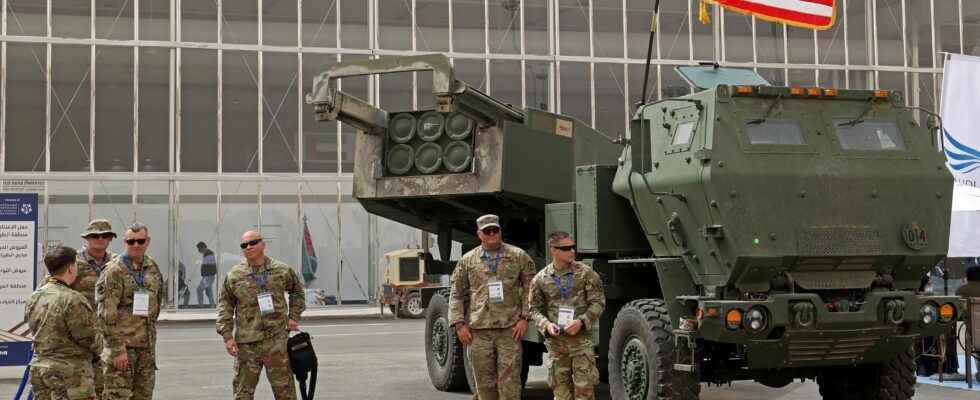In Ukraine, this weapon is a source of pride, and a source of motivation to continue the war, with the conviction that victory is possible. Offered by the United States, the “Himars” is the object of a real cult there and is displayed on the t-shirts or on the skin of those who do not hesitate to have their silhouette tattooed. For the Russians, it is a nightmare, as it sows death and destruction in their ranks.
The M142 High Mobility Artillery Rocket System, its full name, owes its popularity to its formidable efficiency. This multiple rocket launcher system changed the tide of the war, tipping the balance in favor of kyiv. Since then, European armies have been snapping it up, swelling the order books of its manufacturer, the American Lockheed Martin. The Himars established itself as the decisive weapon of the year.
Washington provided kyiv with 38 of these wheeled light armored vehicles, which entered service in 2005. Each has a launcher capable of receiving a basket of six rockets equipped with 90 kg explosive warheads. Equipped with GPS guidance, these are capable of hitting a target 80 km away to the nearest meter. Its use by the Ukrainians, from June, allowed the destruction of the ammunition depots of the Russians, as evidenced by gigantic explosions relayed on social networks.
“The Himars are formidable against an army like that of Russia, which does not have the habit of dispersing its logistics and its command centers, notes Yohann Michel, researcher on defense issues at the International Institute for Strategic Studies ( IISS). The Ukrainians also made excellent use of the intelligence they gathered on the ground and that they received from their allies, in particular the Americans.”
The damage inflicted reduced the artillery potential of the Russian forces, halting their advance into the Donbass in early July after the capture of the twin cities of Severodonetsk and Lyssychansk. The Himars also allowed to destroy the bridges over the Dnieper in the Kherson region. Deprived of supplies, isolated, Vladimir Putin’s troops had to retreat to the eastern bank of the river, offering a major victory to their adversaries.
As early as the summer, Russian Defense Minister Sergei Shoigu made the Himars a “priority target”. Without success, since no loss of this weapon has been officially confirmed for the kyiv forces. The ballet of Ukrainian strikes is always the same and makes it possible to avoid counter-battery fire: as soon as the rockets have left and the launcher lowered, the vehicle leaves the launch site to reach a shelter, be reloaded with a new basket of projectiles and wait for the transmission of the coordinates of its next target.
If kyiv only received its first Himars at the end of the spring, it was because Washington feared that Moscow would use it as a reason for widening the conflict. The Ukrainians therefore promised to use it only on targets in the occupied territories. The Pentagon nevertheless refuses to deliver the most powerful ammunition, the ATACMS, with a range of 300 km. And as a precaution, the systems delivered were restrained by the Pentagonso that they could not fire such missiles.
The United States is not the only one to have delivered such weapons to Ukraine. The UK provided six M270s and Germany five. On tracks and not on wheels, this model can transport and fire two baskets of six rockets, against only one for Himars. But it is a heavy armored vehicle, therefore less agile – it is moreover the ancestor of the Himars. Paris, for its part, delivered two LRU (unitary rocket launcher, the name given to its M270).
A system that interests France
Why so little? France possessed, before this delivery, only thirteen. “By choice, deep strikes have been, in France, mainly delegated to the Air Force, explains Yohann Michel. But we realize with the war in Ukraine that it risks being monopolized by other missions in the early days of a conflict of this type, and would not necessarily be able to carry out such strikes. It becomes useful again to have several options.”
The Chief of the Defense Staff, General Thierry Burkhard, made the same observation. during his hearing in the Senate. “It is essential that we have a depth fire capability,” he said. He also recalled that “the Army’s program planned to replace the LRU”, knowing that “the United States has already replaced” their M270 with the Himars.
It remains to be seen how to avoid the “capacity hole”, when the LRUs must reach the end of their life in 2027. “We can buy off the shelf, or offer, for example, to Lockheed Martin, whose American factories will be running at full speed , to set up a production line in Europe in association with an industrialist from the continent”, says Yohann Michel.
Because the order books of the largest arms manufacturer on the planet ($62.5 billion in defense-related turnover in 2021) are full. In 2023, he must deliver twenty Himars to Poland – which is negotiating the purchase of 200 others – then eleven, the following year, to Taiwan. In May, Australia obtained the green light from Washington to acquire twenty machines – Canberra is also participating in the financing of a new missile, the Precision Strike Missile (PrSM) whose range would exceed 500 km.
Bordering Russia, the Baltic countries have each placed an order. Estonia has made the largest arms purchase in its history with the signing for 200 million dollars (190 million euros) of a contract providing for the delivery of six Himars in 2024. Latvia wants them as much. Lithuania has announced its intention to buy eight of them, as well as ATACMS missiles. Enough to inflict significant damage on their Russian neighbor, if he tries to invade them.
